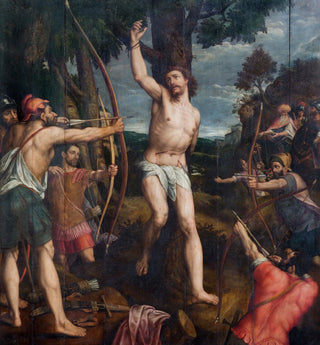The figure of Saint Sebastian has always aroused much curiosity on the part of Christians from all over the world. He is usually depicted as a beautiful, half-naked young man, tied to a tree (or stake) pierced by multiple arrows, to commemorate his martyrdom. He died in 288 AD, his feast day is on 20th of January and he is considered the Patron Saint of Soldiers, Athletes and those who desire a saintly death.
Discover more about Saint Sebastian, by reading the following paragraphs.

Statue of St. Sebastian, Diocese of Vercelli (Italy)
Source: https://cutt.ly/U0m0zeJ
Who was St. Sebastian?
There’s not much information about Saint Sebastian, apart from the fact that he probably came from southern France and he was educated in Milan (Italy). When he was very young, he joined the Roman Army (283 AD), apparently to help other Christians who were being persecuted by Romans, just before Constantine's edict, in 313 AD, which provided for freedom of religion and the end of persecution against Christians. Since he joined the Army, he distinguished himself for his excellent service, at the point that he was promoted to serve in the Praetorian Guard to protect Emperor Diocletian.
 St. Sebastian, miniature by Sandro Botticelli
St. Sebastian, miniature by Sandro Botticelli
Why was St. Sebastian sentenced to death?
During his service as a Praetorian Guard, he converted several prominent individuals to Christianity, including the local prefect. An example of this fact is the conversion of the parents of Marcus and Marcellian, two twin brothers, deacons of the Christian Church, who were imprisoned for refusing to make public sacrifices to the Roman gods. These conversions were reported to Emperor Diocletian, already infamous for ordering the deaths of hundreds of Christians, who ordered him to be killed by having him tied to a stake on a training field and used as target practice. After this condemnation, the archers riddled his body with arrows, as shown in the most famous iconographies. Believed to be dead, the archers left his body for retrieval and burial, which was recovered by Irene of Rome, whose Christian husband was also martyred. When she found out that he was not dead but still alive, she hid him and nursed him back to health, as a great sign of compassion towards that poor man who helped so many Christians during the Roman persecutions.
Once Sebastian completely recovered himself, he went in search of Diocletian to surprise him and criticized him loudly in public for his persecution and sentences of death towards Christians. Shocked to see Sebastian still alive, Diocletian ordered his former guard to be beaten to death with clubs, then thrown into the sewers.
Once again, his body was recovered by a Christian woman (Lucina), who secretly buried him in the catacombs beneath Rome.
Around 80 years later, after Constantine’s edict, his body was moved to a Basilica in Rome and the remains of his body were shared with a community of monks in France. A few centuries later, his cranium was then sent to a German monastery where it was placed in a special silver case, in a special reliquary in Ebersberg.
 Representation of St. Sebastian, by Il Sodoma, 1525, Uffizi Gallery
Representation of St. Sebastian, by Il Sodoma, 1525, Uffizi Gallery
St. Sebastian is the Patron Saint of…
Saint Sebastian was commonly invoked against the plague, which was very widespread at that time. Furthermore, according to historical records, he already protected Rome against the plague in 680. This association with the plague may be because he survived being shot full of arrows and in pagan belief, pestilence was delivered by arrows shot by the gods above. This symbolism was then captured in many Renaissance artworks, where artists painted plague victims with black arrows in their body, just like Saint Sebastian. Today, instead, he is considered the Patron Saint of Soldiers and Athletes, due to this association with the arrows to which he survived. The fact that he survived the arrows was considered a miracle, to such an extent that his real death always took second place, even in the artistic field: in fact, his real death was never depicted in art.
If you are a Soldier, an Athlete or you are just really devoted to Saint Sebastian, this magnificent hand-painted statue below may be of your interest and inspiration.
Related articles:
5 Patron Saints of Soldiers and Military→
The fascinating story of St. George, soldier of God→



